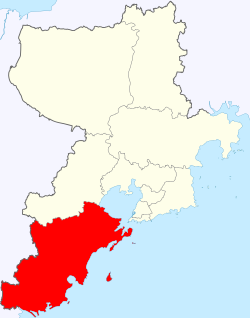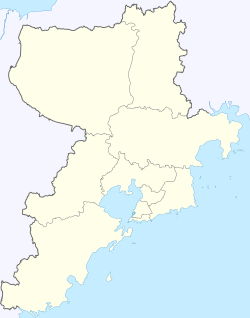Huangdao, Qingdao
District and state-level new area of Qingdao, Shandong, China From Wikipedia, the free encyclopedia
Huangdao District (Chinese: 黄岛区; lit. 'Yellow Island District') and West Coast New Area[1] (Chinese: 西海岸新区), is a district and a state-level new area of Qingdao, Shandong, China, located south-west and west of the main urban area of the city on the western shore of Jiaozhou Bay. It was identical to Qingdao Economic and Technological Development Zone (QETDZ, simplified Chinese: 青岛经济技术开发区; traditional Chinese: 青島經濟技術開發區; pinyin: Qīngdǎo Jīngjì Jìshù Kāifā Qū), which was launched in 1985 after the zone was merged with Huangdao District and set up the Free Trade Zone in 1992. In December 2012, Jiaonan, a county-level city in Qingdao was merged into Huangdao District.[2]
Huangdao District / West Coast New Area
黄岛区 / 西海岸新区 | |
|---|---|
| Huangdao District / West Coast New Area | |
 | |
 Huangdao / West Coast New Area in Qingdao | |
| Coordinates: 35°52′22″N 120°02′46″E | |
| Country | China |
| Province | Shandong |
| Sub-provincial city | Qingdao |
| Township-level divisions | 12 subdistricts 10 towns |
| District seat | Yinzhu Subdistrict (隐珠街道) |
| Area | |
• Total | 2,220.10 km2 (857.19 sq mi) |
| Elevation | 25 m (83 ft) |
| Population (2019) | |
• Total | 1,608,200 |
| • Density | 720/km2 (1,900/sq mi) |
| Time zone | UTC+08:00 (China Standard) |
| Postal code | 266400, 266500 |
| Area code | 0532 |
| Website | HuangDao.gov.cn |
| Huangdao District | |||||||
|---|---|---|---|---|---|---|---|
| Traditional Chinese | 黃島區 | ||||||
| Simplified Chinese | 黄岛区 | ||||||
| Literal meaning | Yellow Island District | ||||||
| |||||||
| West Coast New Area | |||||||
| Traditional Chinese | 西海岸新區 | ||||||
| Simplified Chinese | 西海岸新区 | ||||||
| |||||||
The pillar industries engaged in the zone include electronics, household electric appliances, building materials, petrochemicals, machinery and pharmaceutical drugs.[3][4] It is connected via Qingdao Jiaozhou Bay Bridge.
In mid 2018, the Ministry of Civil Affairs approved the consolidation of Huangdao District Government and West Coast New Area Government into a single governing body, which became the fourth administrative state-level new areas after Pudong of Shanghai; Binhai of Tianjin; and Nansha of Guangzhou. The population was 1.71 million in 2014.
Administrative divisions
Summarize
Perspective

Huangdao District is the earliest key area of Qingdao's opening-up to the outside world. In 1985, the Qingdao Economic and Technological Development Zone was built in Huangdao District. In 1992, with the approval of the Shandong Provincial Party Committee and Government, the total area of Qingdao Economic and Technological Development Zone and Huangdao District was expanded to 217.33 square kilometers after the integration of the two district systems. In 2004, the original renovation system of Hongshiya Town in Jiaonan City was transferred to Huangdao District, and the area was further expanded to 274.1 square kilometers. Huangdao is divided into 12 subdistricts and 10 more rural towns; the latter half of the current subdistricts and all towns were ceded from Jiaonan City.[5][6]
- Subdistricts
|
|
- Towns
|
|
Transport
The Jiaozhou Bay Ring Expressway from Huangdao to Qingdao urban area has a total length of 66 kilometers. The Jiaozhou Bay Bridge in Qingdao has a total length of 36.48 kilometers connecting Huangdao, Qingdao, and Hongdao. The Qingdao Jiaozhou Bay Underwater Tunnel has a length of 3950 meters in the underwater section connecting the two cities.
Maritime transportation
- Qianwan Port: The seventh largest port in the world, with 75 berths/15.52 million TEUs (2013).[citation needed]
China Railway
Qingdao Metro
Climate
| Climate data for Huangdao (Zhuhai Subdistrict), elevation 10 m (33 ft), (1991–2020 normals, extremes 1981–2010) | |||||||||||||
|---|---|---|---|---|---|---|---|---|---|---|---|---|---|
| Month | Jan | Feb | Mar | Apr | May | Jun | Jul | Aug | Sep | Oct | Nov | Dec | Year |
| Record high °C (°F) | 15.2 (59.4) |
19.7 (67.5) |
24.8 (76.6) |
35.9 (96.6) |
35.0 (95.0) |
36.6 (97.9) |
41.0 (105.8) |
35.8 (96.4) |
38.0 (100.4) |
30.5 (86.9) |
25.6 (78.1) |
18.6 (65.5) |
41.0 (105.8) |
| Mean daily maximum °C (°F) | 4.3 (39.7) |
6.7 (44.1) |
11.6 (52.9) |
17.5 (63.5) |
23.0 (73.4) |
25.9 (78.6) |
29.0 (84.2) |
29.5 (85.1) |
26.4 (79.5) |
21.0 (69.8) |
13.6 (56.5) |
6.7 (44.1) |
17.9 (64.3) |
| Daily mean °C (°F) | −0.5 (31.1) |
1.8 (35.2) |
6.6 (43.9) |
12.5 (54.5) |
18.1 (64.6) |
21.8 (71.2) |
25.6 (78.1) |
26.0 (78.8) |
22.1 (71.8) |
16.0 (60.8) |
8.6 (47.5) |
1.9 (35.4) |
13.4 (56.1) |
| Mean daily minimum °C (°F) | −4.1 (24.6) |
−2.0 (28.4) |
2.4 (36.3) |
8.2 (46.8) |
13.9 (57.0) |
18.7 (65.7) |
23.0 (73.4) |
23.2 (73.8) |
18.3 (64.9) |
11.6 (52.9) |
4.4 (39.9) |
−1.8 (28.8) |
9.7 (49.4) |
| Record low °C (°F) | −16.2 (2.8) |
−15.1 (4.8) |
−8.1 (17.4) |
−2.8 (27.0) |
3.4 (38.1) |
9.7 (49.5) |
16.5 (61.7) |
14.8 (58.6) |
6.6 (43.9) |
−1.4 (29.5) |
−7.7 (18.1) |
−12.6 (9.3) |
−16.2 (2.8) |
| Average precipitation mm (inches) | 10.9 (0.43) |
17.7 (0.70) |
20.4 (0.80) |
34.8 (1.37) |
72.8 (2.87) |
76.9 (3.03) |
156.3 (6.15) |
192.4 (7.57) |
90.3 (3.56) |
37.4 (1.47) |
37.2 (1.46) |
14.9 (0.59) |
762 (30) |
| Average precipitation days (≥ 0.1 mm) | 3.0 | 4.0 | 4.7 | 6.4 | 7.9 | 8.4 | 11.7 | 11.5 | 7.2 | 5.3 | 5.4 | 3.6 | 79.1 |
| Average snowy days | 3.6 | 3.0 | 1.3 | 0.1 | 0 | 0 | 0 | 0 | 0 | 0 | 0.7 | 2.4 | 11.1 |
| Average relative humidity (%) | 63 | 64 | 63 | 64 | 69 | 79 | 84 | 82 | 73 | 67 | 67 | 63 | 70 |
| Mean monthly sunshine hours | 166.7 | 165.8 | 212.1 | 224.8 | 239.5 | 199.2 | 178.4 | 193.4 | 202.2 | 199.8 | 170.1 | 166.9 | 2,318.9 |
| Percentage possible sunshine | 54 | 54 | 57 | 57 | 55 | 46 | 41 | 47 | 55 | 58 | 56 | 55 | 53 |
| Source: China Meteorological Administration[7][8] | |||||||||||||
References
External links
Wikiwand - on
Seamless Wikipedia browsing. On steroids.


